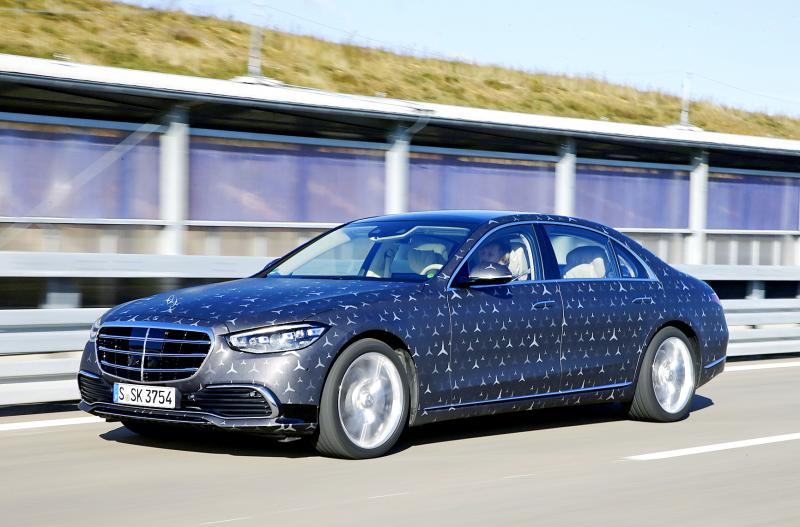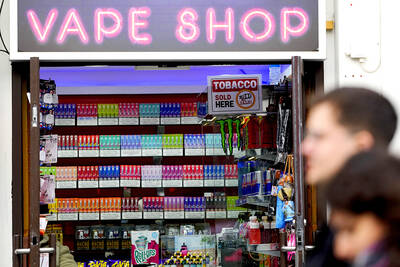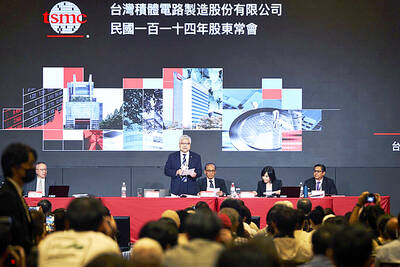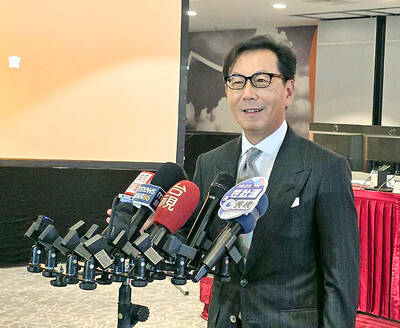As Tesla Inc touted the cutting-edge nature of its new “full self-driving” (FSD) software, rival Mercedes-Benz said it has developed a similar system, but stopped short of allowing members of the public to take it on urban roads.
The Germans, pioneers in developing advanced driver assistance systems, are taking a step-by-step approach to releasing new technology, waiting for their own engineers, rather than the general public, to validate their system.
Both approaches — one conservative and one radical in nature — are designed to push highly automated driving on to public roads, a step that could massively reduce accidents, as computers have faster accident-avoidance reflexes than humans.

Photo: Reuters
Advanced driver assistance systems can provide steering, braking and acceleration support under limited circumstances, generally on highways. Automakers have refrained from relying on their technology to let vehicles navigate urban inner-city traffic.
Tesla broke this tradition last week when it released its FSD software, which allows its computer-powered vehicles to practice their reflexes in inner-city traffic situations, with a warning that its vehicles “may do the wrong thing at the worst time.”
Mercedes does not allow members of the public to test experimental systems.
Its engineers need to pass an eligibility exam to become test drivers, and another one for testing automated driving systems, the automaker said.
Rather than force their customers to put their trust in processors, software and the ability of machines to learn over time, the Germans want their vehicles to be validated by engineers so that they remain predictable for owners.
“We do not want blind trust. We want informed trust in the car. The customer needs to know exactly what the car can and cannot do,” a Mercedes spokesman told reporters on the sidelines of the company’s test track in Immendingen, Germany.
“The worst thing would be if the car gets into a complex situation and there was ambiguity over whether the car is in control or not,” he said.
This is why the Stuttgart-based automaker, owned by Daimler AG, is emphasizing its decades-old experience of automated driver assistance systems as it seeks to gain global regulatory approval for its own “drive pilot” system, which boasts level 3 automation.
Level 3 means the driver can legally take their eyes off the wheel and the company, Daimler in this case, would have to assume insurance liability, depending on the jurisdiction.
The new Tesla system forces customers to take responsibility for any crash.
Mercedes-Benz started using camera-based systems in 2009, offering traffic-light recognition and lane-keeping assistance systems, switching to stereo cameras in 2013, to add depth of field and pedestrian recognition for emergency braking functions.
It was on a joint development project between the Tesla Model S and the Mercedes-Benz electric B-Class that Tesla chief executive officer Elon Musk learned about camera and radar-based assistance systems, senior engineers familiar with the project told reporters.
Mercedes plans to launch drive pilot next year and is pitching it as an evolution of its Distronic system, launched in 2013, which uses cameras and radar to keep vehicles in lane and at a distance to the vehicle in front.
Drive pilot would add a new sensor: lidar, to cross-reference data gathered by radar, ultrasonic sensors, high-definition mapping, radar and cameras.
“It is a paradigm change from Distronic, but it is a strategic evolution. For us this is the logical next step and it is not shooting for the moon,” said Michael Decker, manager of automated driving at Mercedes-Benz Cars, while standing on the Immendingen test grounds, where Mercedes hones autonomous driving systems.
Decker, behind the wheel of a new S-Class, drove the car onto a stretch of road mocked up to replicate an autobahn and selected drive pilot. The car glided seamlessly, providing gentle braking and steering inputs to keep its place in moving traffic.
“I spend most of my time dealing with edge cases, those special situations that we need to have under control,” he said.
The Mercedes drive pilot would only work at up to 60kph and reach higher speeds once the legal framework allows. It would function only on highways in Germany from the middle of next year, if a new law is passed.
“If the car crosses the border into France, it will disengage, because we use high-definition mapping as one of our validation systems, and France has not created the legal framework for allowing this system to operate,” Decker said.
Although Mercedes engineers are aware of Tesla’s more aggressive approach to marketing their systems, they appear unruffled.
“Yes. We always followed this path. And we now see that we have the right strategy,” Decker said.
“What is paramount here is safety. This is about having a mature system. Mercedes safety standards stand over and above everything, including speed,” he added.

CAUTIOUS RECOVERY: While the manufacturing sector returned to growth amid the US-China trade truce, firms remain wary as uncertainty clouds the outlook, the CIER said The local manufacturing sector returned to expansion last month, as the official purchasing managers’ index (PMI) rose 2.1 points to 51.0, driven by a temporary easing in US-China trade tensions, the Chung-Hua Institution for Economic Research (CIER, 中華經濟研究院) said yesterday. The PMI gauges the health of the manufacturing industry, with readings above 50 indicating expansion and those below 50 signaling contraction. “Firms are not as pessimistic as they were in April, but they remain far from optimistic,” CIER president Lien Hsien-ming (連賢明) said at a news conference. The full impact of US tariff decisions is unlikely to become clear until later this month

Popular vape brands such as Geek Bar might get more expensive in the US — if you can find them at all. Shipments of vapes from China to the US ground to a near halt last month from a year ago, official data showed, hit by US President Donald Trump’s tariffs and a crackdown on unauthorized e-cigarettes in the world’s biggest market for smoking alternatives. That includes Geek Bar, a brand of flavored vapes that is not authorized to sell in the US, but which had been widely available due to porous import controls. One retailer, who asked not to be named, because

CHIP DUTIES: TSMC said it voiced its concerns to Washington about tariffs, telling the US commerce department that it wants ‘fair treatment’ to protect its competitiveness Taiwan Semiconductor Manufacturing Co (TSMC, 台積電) yesterday reiterated robust business prospects for this year as strong artificial intelligence (AI) chip demand from Nvidia Corp and other customers would absorb the impacts of US tariffs. “The impact of tariffs would be indirect, as the custom tax is the importers’ responsibility, not the exporters,” TSMC chairman and chief executive officer C.C. Wei (魏哲家) said at the chipmaker’s annual shareholders’ meeting in Hsinchu City. TSMC’s business could be affected if people become reluctant to buy electronics due to inflated prices, Wei said. In addition, the chipmaker has voiced its concern to the US Department of Commerce

STILL LOADED: Last year’s richest person, Quanta Computer Inc chairman Barry Lam, dropped to second place despite an 8 percent increase in his wealth to US$12.6 billion Staff writer, with CNA Daniel Tsai (蔡明忠) and Richard Tsai (蔡明興), the brothers who run Fubon Group (富邦集團), topped the Forbes list of Taiwan’s 50 richest people this year, released on Wednesday in New York. The magazine said that a stronger New Taiwan dollar pushed the combined wealth of Taiwan’s 50 richest people up 13 percent, from US$174 billion to US$197 billion, with 36 of the people on the list seeing their wealth increase. That came as Taiwan’s economy grew 4.6 percent last year, its fastest pace in three years, driven by the strong performance of the semiconductor industry, the magazine said. The Tsai